Leadership Implications in Tesco: An Analysis of Contemporary Issues
VerifiedAdded on 2023/06/15
|17
|4507
|50
AI Summary
This report analyzes the contemporary issue of unequal pay grade in Tesco and its leadership implications. It discusses various models and concepts of leadership and evaluates the case study of Tesco. The report concludes that leadership in contemporary organizations depends on situations and the interest of the group of people that they are leading.
Contribute Materials
Your contribution can guide someone’s learning journey. Share your
documents today.

1410207
Secure Best Marks with AI Grader
Need help grading? Try our AI Grader for instant feedback on your assignments.
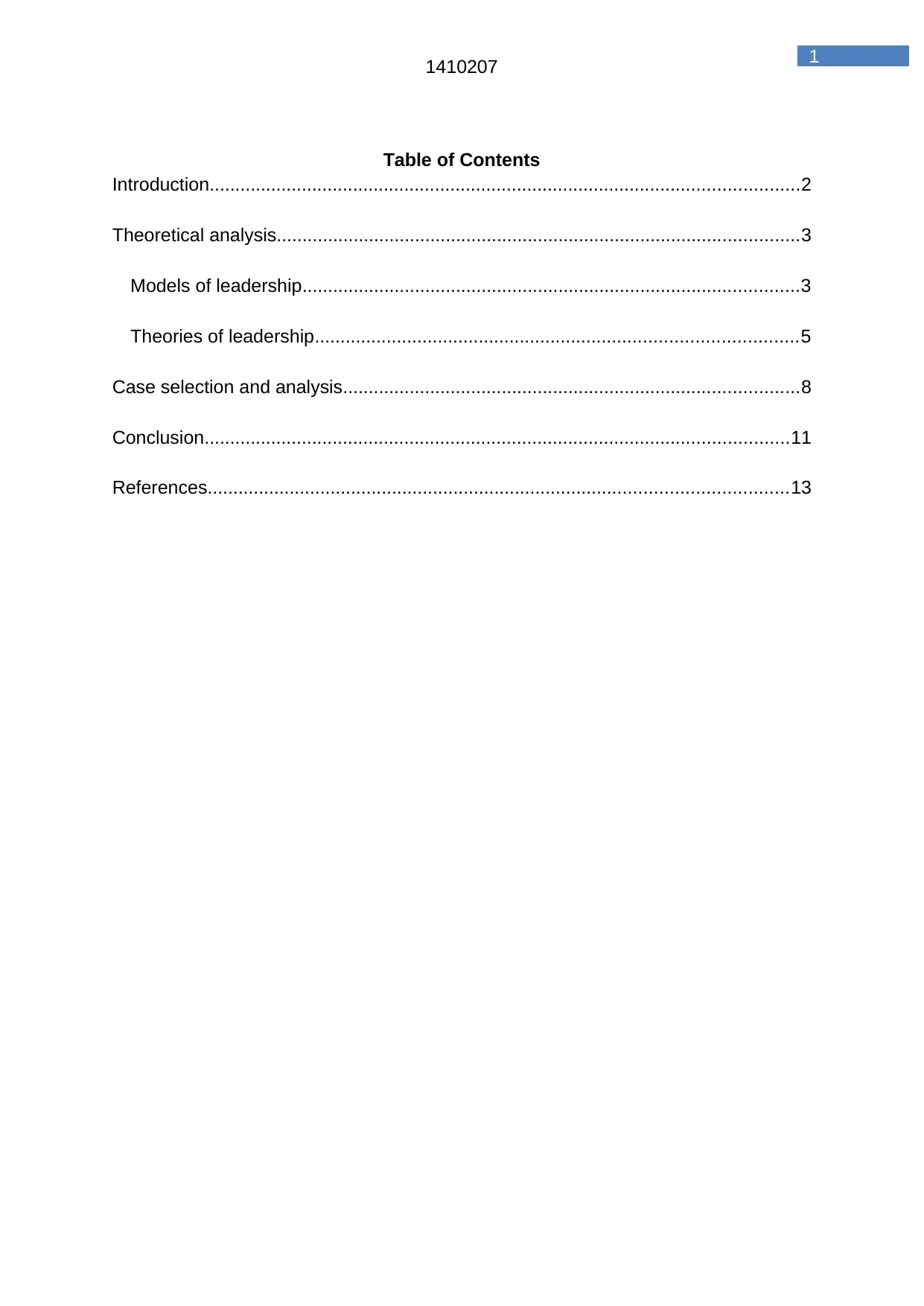
1
1410207
Table of Contents
Introduction...................................................................................................................2
Theoretical analysis......................................................................................................3
Models of leadership.................................................................................................3
Theories of leadership..............................................................................................5
Case selection and analysis.........................................................................................8
Conclusion..................................................................................................................11
References.................................................................................................................13
1410207
Table of Contents
Introduction...................................................................................................................2
Theoretical analysis......................................................................................................3
Models of leadership.................................................................................................3
Theories of leadership..............................................................................................5
Case selection and analysis.........................................................................................8
Conclusion..................................................................................................................11
References.................................................................................................................13
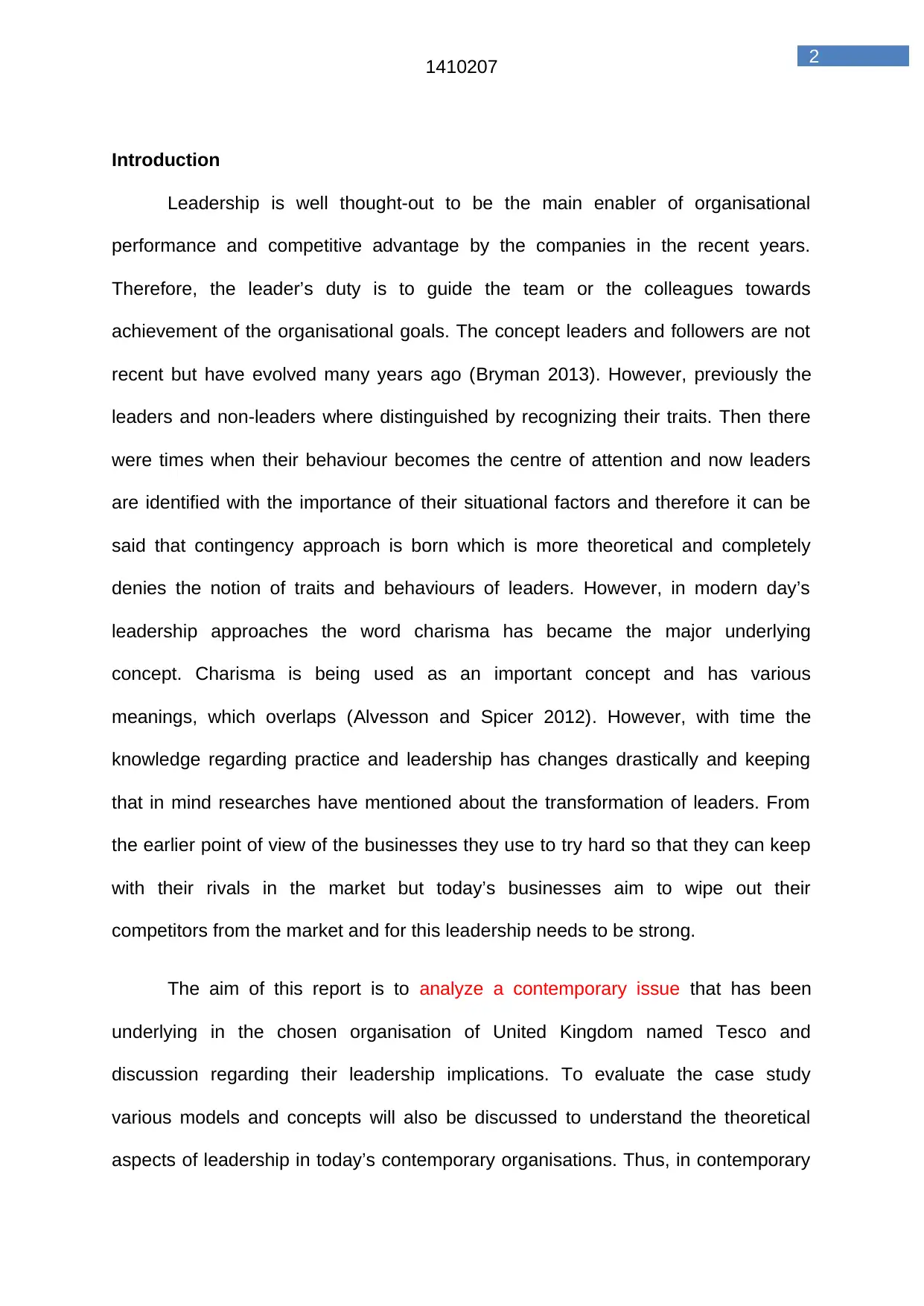
2
1410207
Introduction
Leadership is well thought-out to be the main enabler of organisational
performance and competitive advantage by the companies in the recent years.
Therefore, the leader’s duty is to guide the team or the colleagues towards
achievement of the organisational goals. The concept leaders and followers are not
recent but have evolved many years ago (Bryman 2013). However, previously the
leaders and non-leaders where distinguished by recognizing their traits. Then there
were times when their behaviour becomes the centre of attention and now leaders
are identified with the importance of their situational factors and therefore it can be
said that contingency approach is born which is more theoretical and completely
denies the notion of traits and behaviours of leaders. However, in modern day’s
leadership approaches the word charisma has became the major underlying
concept. Charisma is being used as an important concept and has various
meanings, which overlaps (Alvesson and Spicer 2012). However, with time the
knowledge regarding practice and leadership has changes drastically and keeping
that in mind researches have mentioned about the transformation of leaders. From
the earlier point of view of the businesses they use to try hard so that they can keep
with their rivals in the market but today’s businesses aim to wipe out their
competitors from the market and for this leadership needs to be strong.
The aim of this report is to analyze a contemporary issue that has been
underlying in the chosen organisation of United Kingdom named Tesco and
discussion regarding their leadership implications. To evaluate the case study
various models and concepts will also be discussed to understand the theoretical
aspects of leadership in today’s contemporary organisations. Thus, in contemporary
1410207
Introduction
Leadership is well thought-out to be the main enabler of organisational
performance and competitive advantage by the companies in the recent years.
Therefore, the leader’s duty is to guide the team or the colleagues towards
achievement of the organisational goals. The concept leaders and followers are not
recent but have evolved many years ago (Bryman 2013). However, previously the
leaders and non-leaders where distinguished by recognizing their traits. Then there
were times when their behaviour becomes the centre of attention and now leaders
are identified with the importance of their situational factors and therefore it can be
said that contingency approach is born which is more theoretical and completely
denies the notion of traits and behaviours of leaders. However, in modern day’s
leadership approaches the word charisma has became the major underlying
concept. Charisma is being used as an important concept and has various
meanings, which overlaps (Alvesson and Spicer 2012). However, with time the
knowledge regarding practice and leadership has changes drastically and keeping
that in mind researches have mentioned about the transformation of leaders. From
the earlier point of view of the businesses they use to try hard so that they can keep
with their rivals in the market but today’s businesses aim to wipe out their
competitors from the market and for this leadership needs to be strong.
The aim of this report is to analyze a contemporary issue that has been
underlying in the chosen organisation of United Kingdom named Tesco and
discussion regarding their leadership implications. To evaluate the case study
various models and concepts will also be discussed to understand the theoretical
aspects of leadership in today’s contemporary organisations. Thus, in contemporary
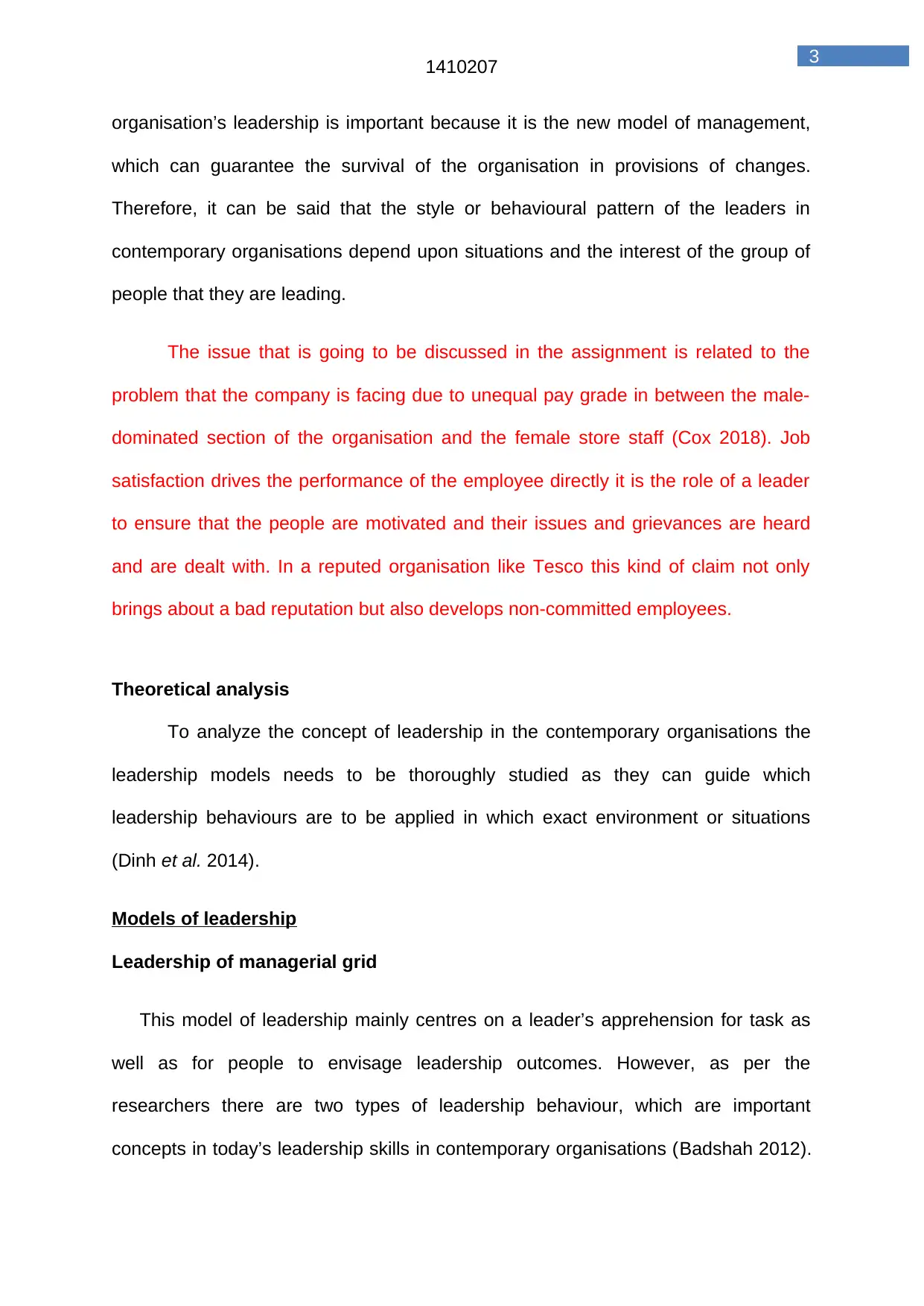
3
1410207
organisation’s leadership is important because it is the new model of management,
which can guarantee the survival of the organisation in provisions of changes.
Therefore, it can be said that the style or behavioural pattern of the leaders in
contemporary organisations depend upon situations and the interest of the group of
people that they are leading.
The issue that is going to be discussed in the assignment is related to the
problem that the company is facing due to unequal pay grade in between the male-
dominated section of the organisation and the female store staff (Cox 2018). Job
satisfaction drives the performance of the employee directly it is the role of a leader
to ensure that the people are motivated and their issues and grievances are heard
and are dealt with. In a reputed organisation like Tesco this kind of claim not only
brings about a bad reputation but also develops non-committed employees.
Theoretical analysis
To analyze the concept of leadership in the contemporary organisations the
leadership models needs to be thoroughly studied as they can guide which
leadership behaviours are to be applied in which exact environment or situations
(Dinh et al. 2014).
Models of leadership
Leadership of managerial grid
This model of leadership mainly centres on a leader’s apprehension for task as
well as for people to envisage leadership outcomes. However, as per the
researchers there are two types of leadership behaviour, which are important
concepts in today’s leadership skills in contemporary organisations (Badshah 2012).
1410207
organisation’s leadership is important because it is the new model of management,
which can guarantee the survival of the organisation in provisions of changes.
Therefore, it can be said that the style or behavioural pattern of the leaders in
contemporary organisations depend upon situations and the interest of the group of
people that they are leading.
The issue that is going to be discussed in the assignment is related to the
problem that the company is facing due to unequal pay grade in between the male-
dominated section of the organisation and the female store staff (Cox 2018). Job
satisfaction drives the performance of the employee directly it is the role of a leader
to ensure that the people are motivated and their issues and grievances are heard
and are dealt with. In a reputed organisation like Tesco this kind of claim not only
brings about a bad reputation but also develops non-committed employees.
Theoretical analysis
To analyze the concept of leadership in the contemporary organisations the
leadership models needs to be thoroughly studied as they can guide which
leadership behaviours are to be applied in which exact environment or situations
(Dinh et al. 2014).
Models of leadership
Leadership of managerial grid
This model of leadership mainly centres on a leader’s apprehension for task as
well as for people to envisage leadership outcomes. However, as per the
researchers there are two types of leadership behaviour, which are important
concepts in today’s leadership skills in contemporary organisations (Badshah 2012).
Secure Best Marks with AI Grader
Need help grading? Try our AI Grader for instant feedback on your assignments.
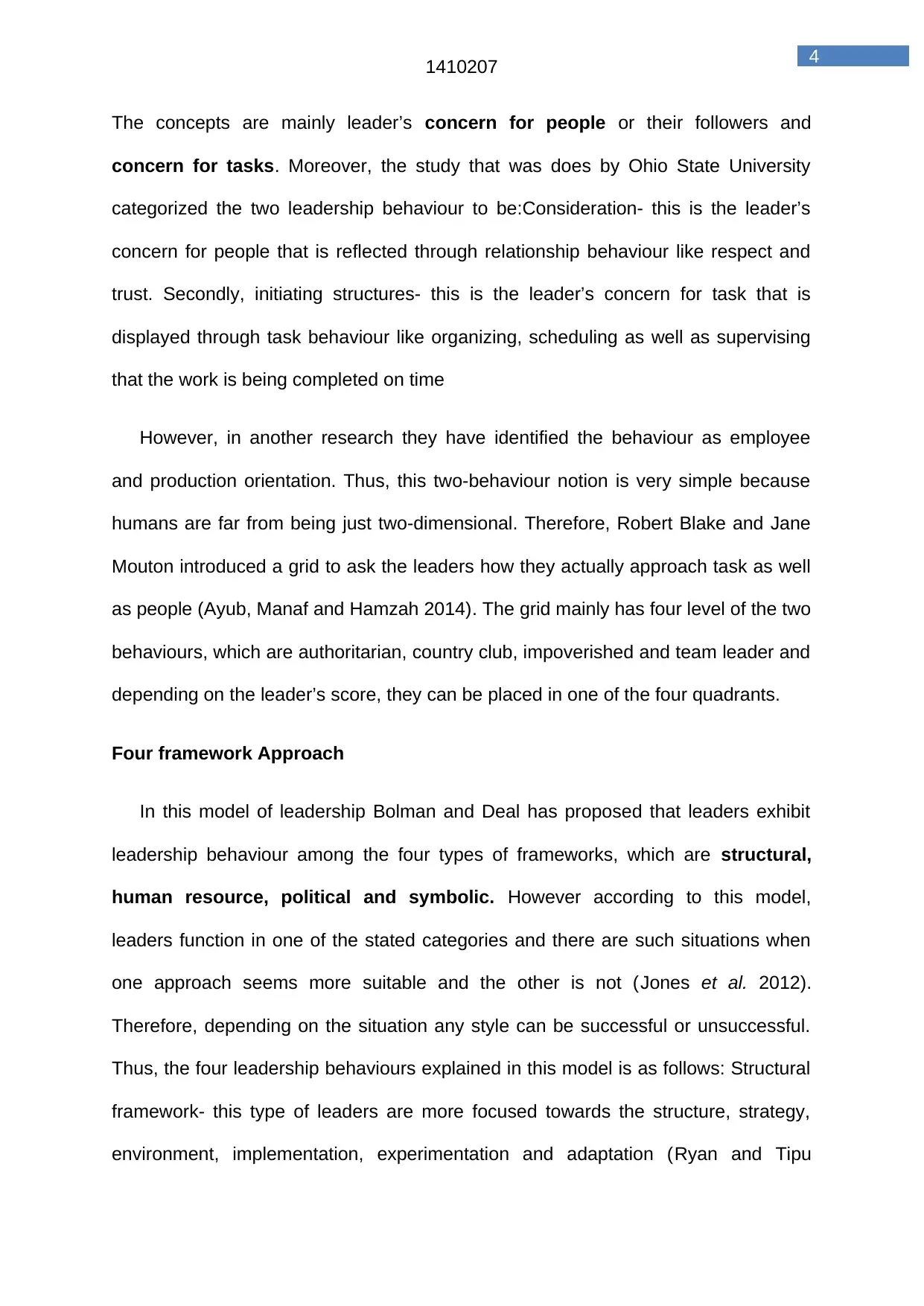
4
1410207
The concepts are mainly leader’s concern for people or their followers and
concern for tasks. Moreover, the study that was does by Ohio State University
categorized the two leadership behaviour to be:Consideration- this is the leader’s
concern for people that is reflected through relationship behaviour like respect and
trust. Secondly, initiating structures- this is the leader’s concern for task that is
displayed through task behaviour like organizing, scheduling as well as supervising
that the work is being completed on time
However, in another research they have identified the behaviour as employee
and production orientation. Thus, this two-behaviour notion is very simple because
humans are far from being just two-dimensional. Therefore, Robert Blake and Jane
Mouton introduced a grid to ask the leaders how they actually approach task as well
as people (Ayub, Manaf and Hamzah 2014). The grid mainly has four level of the two
behaviours, which are authoritarian, country club, impoverished and team leader and
depending on the leader’s score, they can be placed in one of the four quadrants.
Four framework Approach
In this model of leadership Bolman and Deal has proposed that leaders exhibit
leadership behaviour among the four types of frameworks, which are structural,
human resource, political and symbolic. However according to this model,
leaders function in one of the stated categories and there are such situations when
one approach seems more suitable and the other is not (Jones et al. 2012).
Therefore, depending on the situation any style can be successful or unsuccessful.
Thus, the four leadership behaviours explained in this model is as follows: Structural
framework- this type of leaders are more focused towards the structure, strategy,
environment, implementation, experimentation and adaptation (Ryan and Tipu
1410207
The concepts are mainly leader’s concern for people or their followers and
concern for tasks. Moreover, the study that was does by Ohio State University
categorized the two leadership behaviour to be:Consideration- this is the leader’s
concern for people that is reflected through relationship behaviour like respect and
trust. Secondly, initiating structures- this is the leader’s concern for task that is
displayed through task behaviour like organizing, scheduling as well as supervising
that the work is being completed on time
However, in another research they have identified the behaviour as employee
and production orientation. Thus, this two-behaviour notion is very simple because
humans are far from being just two-dimensional. Therefore, Robert Blake and Jane
Mouton introduced a grid to ask the leaders how they actually approach task as well
as people (Ayub, Manaf and Hamzah 2014). The grid mainly has four level of the two
behaviours, which are authoritarian, country club, impoverished and team leader and
depending on the leader’s score, they can be placed in one of the four quadrants.
Four framework Approach
In this model of leadership Bolman and Deal has proposed that leaders exhibit
leadership behaviour among the four types of frameworks, which are structural,
human resource, political and symbolic. However according to this model,
leaders function in one of the stated categories and there are such situations when
one approach seems more suitable and the other is not (Jones et al. 2012).
Therefore, depending on the situation any style can be successful or unsuccessful.
Thus, the four leadership behaviours explained in this model is as follows: Structural
framework- this type of leaders are more focused towards the structure, strategy,
environment, implementation, experimentation and adaptation (Ryan and Tipu
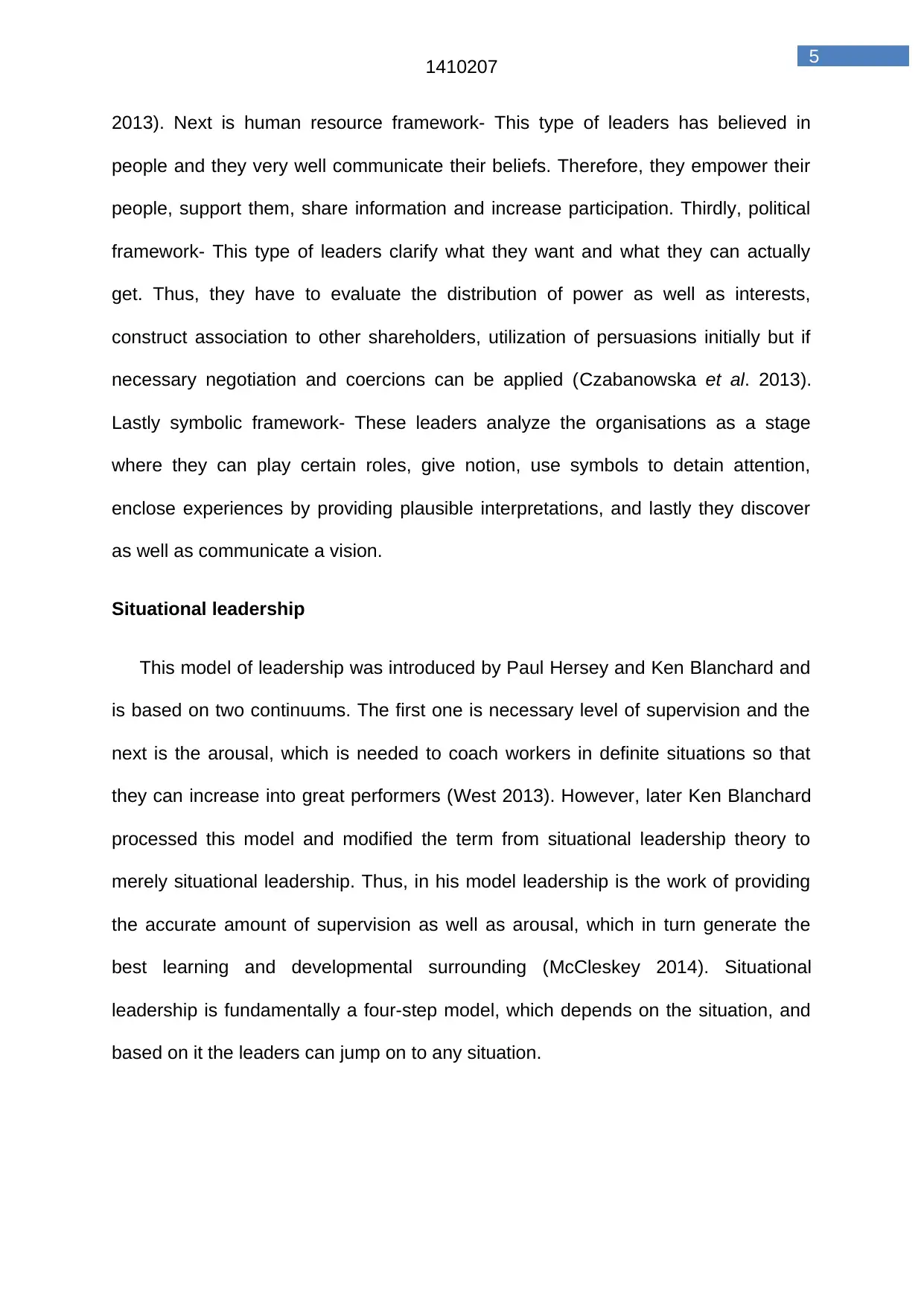
5
1410207
2013). Next is human resource framework- This type of leaders has believed in
people and they very well communicate their beliefs. Therefore, they empower their
people, support them, share information and increase participation. Thirdly, political
framework- This type of leaders clarify what they want and what they can actually
get. Thus, they have to evaluate the distribution of power as well as interests,
construct association to other shareholders, utilization of persuasions initially but if
necessary negotiation and coercions can be applied (Czabanowska et al. 2013).
Lastly symbolic framework- These leaders analyze the organisations as a stage
where they can play certain roles, give notion, use symbols to detain attention,
enclose experiences by providing plausible interpretations, and lastly they discover
as well as communicate a vision.
Situational leadership
This model of leadership was introduced by Paul Hersey and Ken Blanchard and
is based on two continuums. The first one is necessary level of supervision and the
next is the arousal, which is needed to coach workers in definite situations so that
they can increase into great performers (West 2013). However, later Ken Blanchard
processed this model and modified the term from situational leadership theory to
merely situational leadership. Thus, in his model leadership is the work of providing
the accurate amount of supervision as well as arousal, which in turn generate the
best learning and developmental surrounding (McCleskey 2014). Situational
leadership is fundamentally a four-step model, which depends on the situation, and
based on it the leaders can jump on to any situation.
1410207
2013). Next is human resource framework- This type of leaders has believed in
people and they very well communicate their beliefs. Therefore, they empower their
people, support them, share information and increase participation. Thirdly, political
framework- This type of leaders clarify what they want and what they can actually
get. Thus, they have to evaluate the distribution of power as well as interests,
construct association to other shareholders, utilization of persuasions initially but if
necessary negotiation and coercions can be applied (Czabanowska et al. 2013).
Lastly symbolic framework- These leaders analyze the organisations as a stage
where they can play certain roles, give notion, use symbols to detain attention,
enclose experiences by providing plausible interpretations, and lastly they discover
as well as communicate a vision.
Situational leadership
This model of leadership was introduced by Paul Hersey and Ken Blanchard and
is based on two continuums. The first one is necessary level of supervision and the
next is the arousal, which is needed to coach workers in definite situations so that
they can increase into great performers (West 2013). However, later Ken Blanchard
processed this model and modified the term from situational leadership theory to
merely situational leadership. Thus, in his model leadership is the work of providing
the accurate amount of supervision as well as arousal, which in turn generate the
best learning and developmental surrounding (McCleskey 2014). Situational
leadership is fundamentally a four-step model, which depends on the situation, and
based on it the leaders can jump on to any situation.
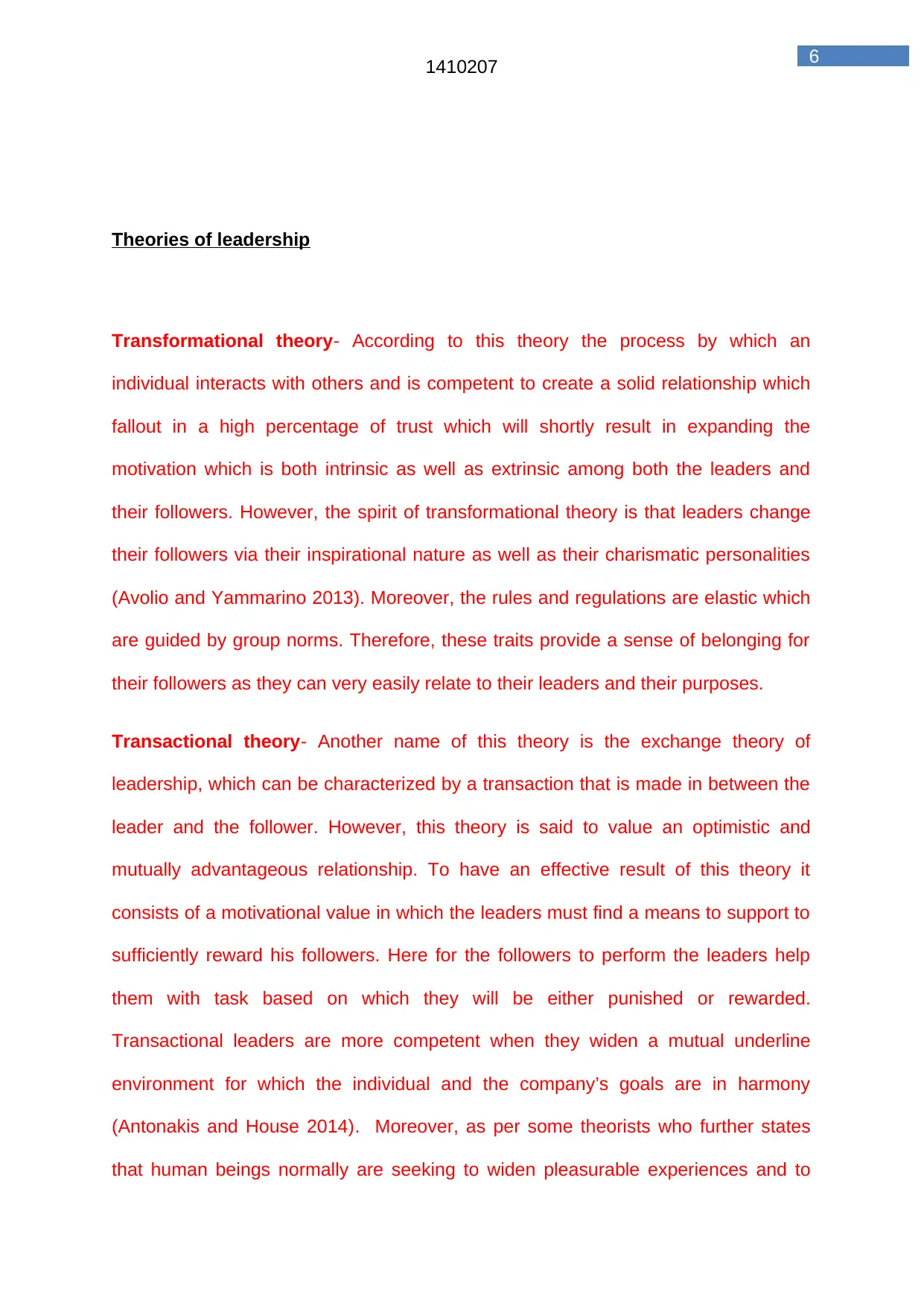
6
1410207
Theories of leadership
Transformational theory- According to this theory the process by which an
individual interacts with others and is competent to create a solid relationship which
fallout in a high percentage of trust which will shortly result in expanding the
motivation which is both intrinsic as well as extrinsic among both the leaders and
their followers. However, the spirit of transformational theory is that leaders change
their followers via their inspirational nature as well as their charismatic personalities
(Avolio and Yammarino 2013). Moreover, the rules and regulations are elastic which
are guided by group norms. Therefore, these traits provide a sense of belonging for
their followers as they can very easily relate to their leaders and their purposes.
Transactional theory- Another name of this theory is the exchange theory of
leadership, which can be characterized by a transaction that is made in between the
leader and the follower. However, this theory is said to value an optimistic and
mutually advantageous relationship. To have an effective result of this theory it
consists of a motivational value in which the leaders must find a means to support to
sufficiently reward his followers. Here for the followers to perform the leaders help
them with task based on which they will be either punished or rewarded.
Transactional leaders are more competent when they widen a mutual underline
environment for which the individual and the company’s goals are in harmony
(Antonakis and House 2014). Moreover, as per some theorists who further states
that human beings normally are seeking to widen pleasurable experiences and to
1410207
Theories of leadership
Transformational theory- According to this theory the process by which an
individual interacts with others and is competent to create a solid relationship which
fallout in a high percentage of trust which will shortly result in expanding the
motivation which is both intrinsic as well as extrinsic among both the leaders and
their followers. However, the spirit of transformational theory is that leaders change
their followers via their inspirational nature as well as their charismatic personalities
(Avolio and Yammarino 2013). Moreover, the rules and regulations are elastic which
are guided by group norms. Therefore, these traits provide a sense of belonging for
their followers as they can very easily relate to their leaders and their purposes.
Transactional theory- Another name of this theory is the exchange theory of
leadership, which can be characterized by a transaction that is made in between the
leader and the follower. However, this theory is said to value an optimistic and
mutually advantageous relationship. To have an effective result of this theory it
consists of a motivational value in which the leaders must find a means to support to
sufficiently reward his followers. Here for the followers to perform the leaders help
them with task based on which they will be either punished or rewarded.
Transactional leaders are more competent when they widen a mutual underline
environment for which the individual and the company’s goals are in harmony
(Antonakis and House 2014). Moreover, as per some theorists who further states
that human beings normally are seeking to widen pleasurable experiences and to
Paraphrase This Document
Need a fresh take? Get an instant paraphrase of this document with our AI Paraphraser
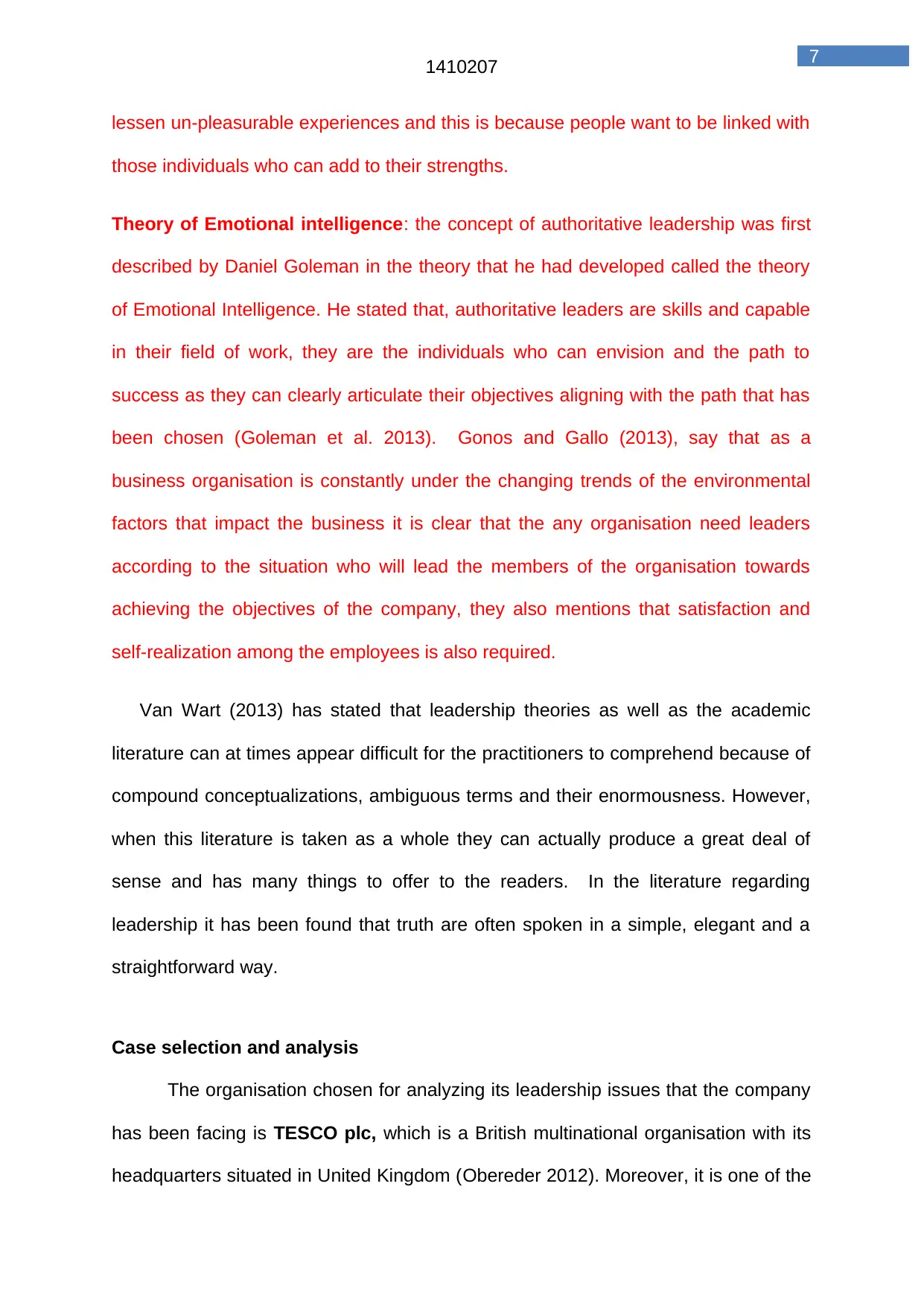
7
1410207
lessen un-pleasurable experiences and this is because people want to be linked with
those individuals who can add to their strengths.
Theory of Emotional intelligence: the concept of authoritative leadership was first
described by Daniel Goleman in the theory that he had developed called the theory
of Emotional Intelligence. He stated that, authoritative leaders are skills and capable
in their field of work, they are the individuals who can envision and the path to
success as they can clearly articulate their objectives aligning with the path that has
been chosen (Goleman et al. 2013). Gonos and Gallo (2013), say that as a
business organisation is constantly under the changing trends of the environmental
factors that impact the business it is clear that the any organisation need leaders
according to the situation who will lead the members of the organisation towards
achieving the objectives of the company, they also mentions that satisfaction and
self-realization among the employees is also required.
Van Wart (2013) has stated that leadership theories as well as the academic
literature can at times appear difficult for the practitioners to comprehend because of
compound conceptualizations, ambiguous terms and their enormousness. However,
when this literature is taken as a whole they can actually produce a great deal of
sense and has many things to offer to the readers. In the literature regarding
leadership it has been found that truth are often spoken in a simple, elegant and a
straightforward way.
Case selection and analysis
The organisation chosen for analyzing its leadership issues that the company
has been facing is TESCO plc, which is a British multinational organisation with its
headquarters situated in United Kingdom (Obereder 2012). Moreover, it is one of the
1410207
lessen un-pleasurable experiences and this is because people want to be linked with
those individuals who can add to their strengths.
Theory of Emotional intelligence: the concept of authoritative leadership was first
described by Daniel Goleman in the theory that he had developed called the theory
of Emotional Intelligence. He stated that, authoritative leaders are skills and capable
in their field of work, they are the individuals who can envision and the path to
success as they can clearly articulate their objectives aligning with the path that has
been chosen (Goleman et al. 2013). Gonos and Gallo (2013), say that as a
business organisation is constantly under the changing trends of the environmental
factors that impact the business it is clear that the any organisation need leaders
according to the situation who will lead the members of the organisation towards
achieving the objectives of the company, they also mentions that satisfaction and
self-realization among the employees is also required.
Van Wart (2013) has stated that leadership theories as well as the academic
literature can at times appear difficult for the practitioners to comprehend because of
compound conceptualizations, ambiguous terms and their enormousness. However,
when this literature is taken as a whole they can actually produce a great deal of
sense and has many things to offer to the readers. In the literature regarding
leadership it has been found that truth are often spoken in a simple, elegant and a
straightforward way.
Case selection and analysis
The organisation chosen for analyzing its leadership issues that the company
has been facing is TESCO plc, which is a British multinational organisation with its
headquarters situated in United Kingdom (Obereder 2012). Moreover, it is one of the
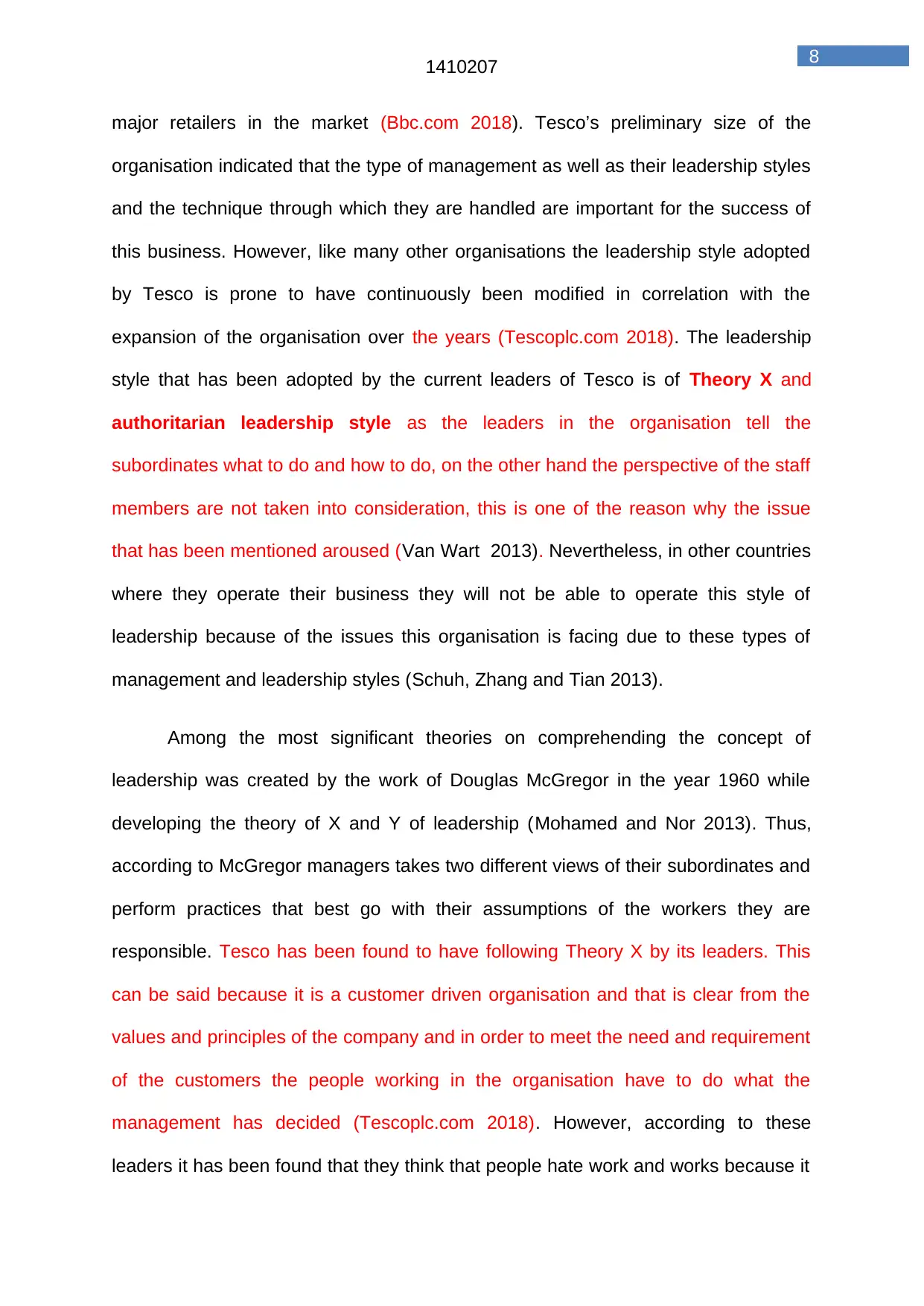
8
1410207
major retailers in the market (Bbc.com 2018). Tesco’s preliminary size of the
organisation indicated that the type of management as well as their leadership styles
and the technique through which they are handled are important for the success of
this business. However, like many other organisations the leadership style adopted
by Tesco is prone to have continuously been modified in correlation with the
expansion of the organisation over the years (Tescoplc.com 2018). The leadership
style that has been adopted by the current leaders of Tesco is of Theory X and
authoritarian leadership style as the leaders in the organisation tell the
subordinates what to do and how to do, on the other hand the perspective of the staff
members are not taken into consideration, this is one of the reason why the issue
that has been mentioned aroused (Van Wart 2013). Nevertheless, in other countries
where they operate their business they will not be able to operate this style of
leadership because of the issues this organisation is facing due to these types of
management and leadership styles (Schuh, Zhang and Tian 2013).
Among the most significant theories on comprehending the concept of
leadership was created by the work of Douglas McGregor in the year 1960 while
developing the theory of X and Y of leadership (Mohamed and Nor 2013). Thus,
according to McGregor managers takes two different views of their subordinates and
perform practices that best go with their assumptions of the workers they are
responsible. Tesco has been found to have following Theory X by its leaders. This
can be said because it is a customer driven organisation and that is clear from the
values and principles of the company and in order to meet the need and requirement
of the customers the people working in the organisation have to do what the
management has decided (Tescoplc.com 2018). However, according to these
leaders it has been found that they think that people hate work and works because it
1410207
major retailers in the market (Bbc.com 2018). Tesco’s preliminary size of the
organisation indicated that the type of management as well as their leadership styles
and the technique through which they are handled are important for the success of
this business. However, like many other organisations the leadership style adopted
by Tesco is prone to have continuously been modified in correlation with the
expansion of the organisation over the years (Tescoplc.com 2018). The leadership
style that has been adopted by the current leaders of Tesco is of Theory X and
authoritarian leadership style as the leaders in the organisation tell the
subordinates what to do and how to do, on the other hand the perspective of the staff
members are not taken into consideration, this is one of the reason why the issue
that has been mentioned aroused (Van Wart 2013). Nevertheless, in other countries
where they operate their business they will not be able to operate this style of
leadership because of the issues this organisation is facing due to these types of
management and leadership styles (Schuh, Zhang and Tian 2013).
Among the most significant theories on comprehending the concept of
leadership was created by the work of Douglas McGregor in the year 1960 while
developing the theory of X and Y of leadership (Mohamed and Nor 2013). Thus,
according to McGregor managers takes two different views of their subordinates and
perform practices that best go with their assumptions of the workers they are
responsible. Tesco has been found to have following Theory X by its leaders. This
can be said because it is a customer driven organisation and that is clear from the
values and principles of the company and in order to meet the need and requirement
of the customers the people working in the organisation have to do what the
management has decided (Tescoplc.com 2018). However, according to these
leaders it has been found that they think that people hate work and works because it
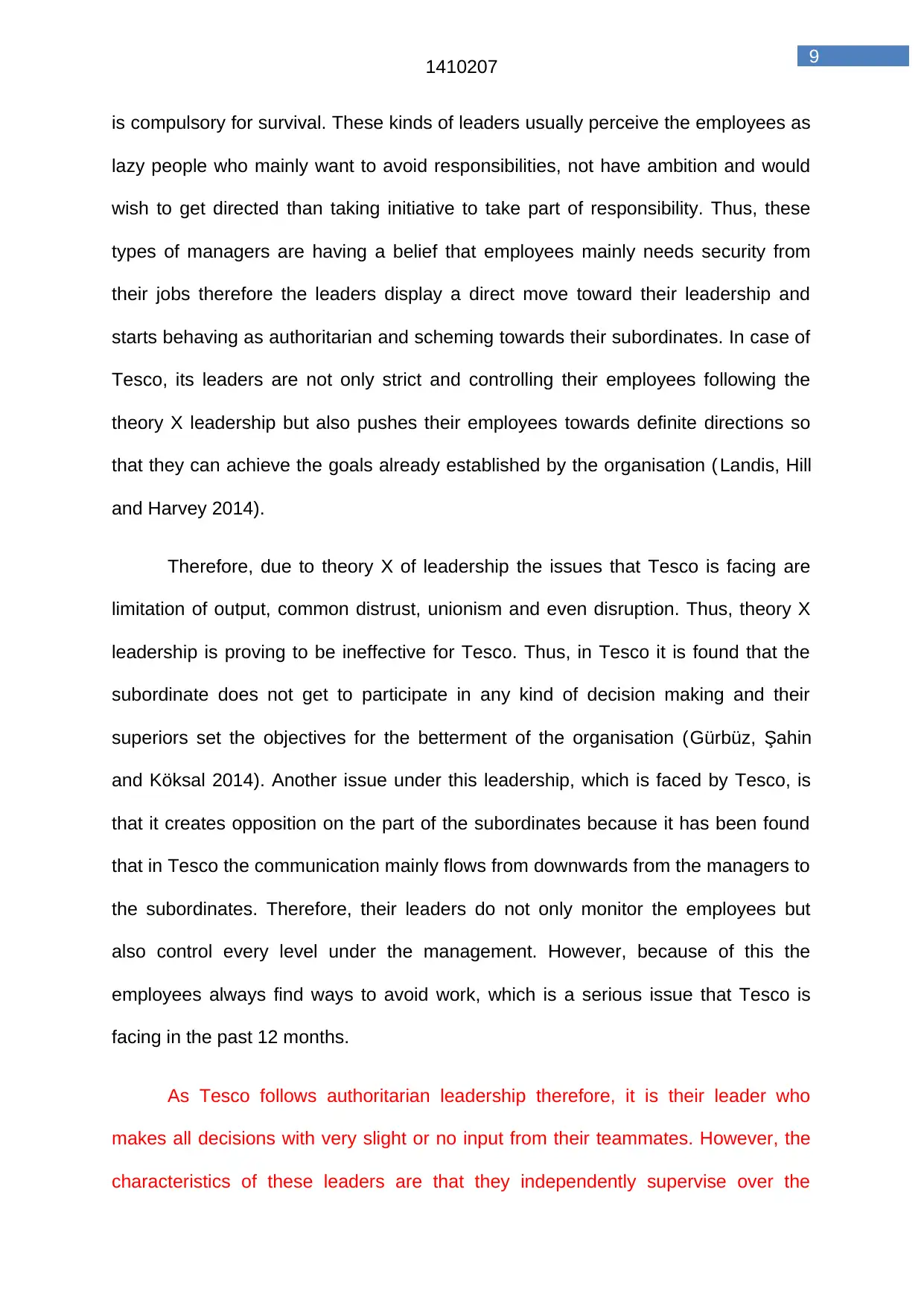
9
1410207
is compulsory for survival. These kinds of leaders usually perceive the employees as
lazy people who mainly want to avoid responsibilities, not have ambition and would
wish to get directed than taking initiative to take part of responsibility. Thus, these
types of managers are having a belief that employees mainly needs security from
their jobs therefore the leaders display a direct move toward their leadership and
starts behaving as authoritarian and scheming towards their subordinates. In case of
Tesco, its leaders are not only strict and controlling their employees following the
theory X leadership but also pushes their employees towards definite directions so
that they can achieve the goals already established by the organisation ( Landis, Hill
and Harvey 2014).
Therefore, due to theory X of leadership the issues that Tesco is facing are
limitation of output, common distrust, unionism and even disruption. Thus, theory X
leadership is proving to be ineffective for Tesco. Thus, in Tesco it is found that the
subordinate does not get to participate in any kind of decision making and their
superiors set the objectives for the betterment of the organisation (Gürbüz, Şahin
and Köksal 2014). Another issue under this leadership, which is faced by Tesco, is
that it creates opposition on the part of the subordinates because it has been found
that in Tesco the communication mainly flows from downwards from the managers to
the subordinates. Therefore, their leaders do not only monitor the employees but
also control every level under the management. However, because of this the
employees always find ways to avoid work, which is a serious issue that Tesco is
facing in the past 12 months.
As Tesco follows authoritarian leadership therefore, it is their leader who
makes all decisions with very slight or no input from their teammates. However, the
characteristics of these leaders are that they independently supervise over the
1410207
is compulsory for survival. These kinds of leaders usually perceive the employees as
lazy people who mainly want to avoid responsibilities, not have ambition and would
wish to get directed than taking initiative to take part of responsibility. Thus, these
types of managers are having a belief that employees mainly needs security from
their jobs therefore the leaders display a direct move toward their leadership and
starts behaving as authoritarian and scheming towards their subordinates. In case of
Tesco, its leaders are not only strict and controlling their employees following the
theory X leadership but also pushes their employees towards definite directions so
that they can achieve the goals already established by the organisation ( Landis, Hill
and Harvey 2014).
Therefore, due to theory X of leadership the issues that Tesco is facing are
limitation of output, common distrust, unionism and even disruption. Thus, theory X
leadership is proving to be ineffective for Tesco. Thus, in Tesco it is found that the
subordinate does not get to participate in any kind of decision making and their
superiors set the objectives for the betterment of the organisation (Gürbüz, Şahin
and Köksal 2014). Another issue under this leadership, which is faced by Tesco, is
that it creates opposition on the part of the subordinates because it has been found
that in Tesco the communication mainly flows from downwards from the managers to
the subordinates. Therefore, their leaders do not only monitor the employees but
also control every level under the management. However, because of this the
employees always find ways to avoid work, which is a serious issue that Tesco is
facing in the past 12 months.
As Tesco follows authoritarian leadership therefore, it is their leader who
makes all decisions with very slight or no input from their teammates. However, the
characteristics of these leaders are that they independently supervise over the
Secure Best Marks with AI Grader
Need help grading? Try our AI Grader for instant feedback on your assignments.
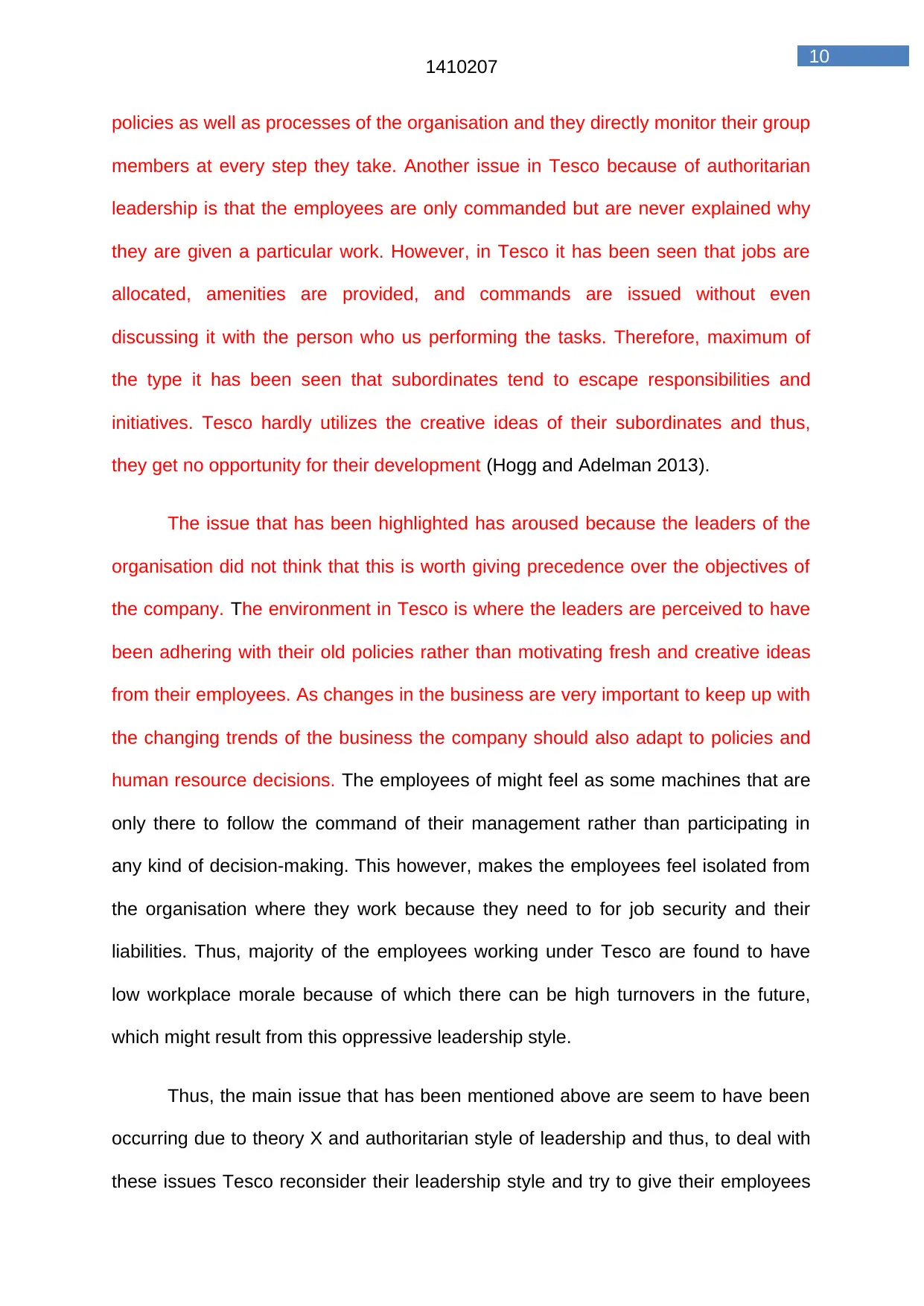
10
1410207
policies as well as processes of the organisation and they directly monitor their group
members at every step they take. Another issue in Tesco because of authoritarian
leadership is that the employees are only commanded but are never explained why
they are given a particular work. However, in Tesco it has been seen that jobs are
allocated, amenities are provided, and commands are issued without even
discussing it with the person who us performing the tasks. Therefore, maximum of
the type it has been seen that subordinates tend to escape responsibilities and
initiatives. Tesco hardly utilizes the creative ideas of their subordinates and thus,
they get no opportunity for their development (Hogg and Adelman 2013).
The issue that has been highlighted has aroused because the leaders of the
organisation did not think that this is worth giving precedence over the objectives of
the company. The environment in Tesco is where the leaders are perceived to have
been adhering with their old policies rather than motivating fresh and creative ideas
from their employees. As changes in the business are very important to keep up with
the changing trends of the business the company should also adapt to policies and
human resource decisions. The employees of might feel as some machines that are
only there to follow the command of their management rather than participating in
any kind of decision-making. This however, makes the employees feel isolated from
the organisation where they work because they need to for job security and their
liabilities. Thus, majority of the employees working under Tesco are found to have
low workplace morale because of which there can be high turnovers in the future,
which might result from this oppressive leadership style.
Thus, the main issue that has been mentioned above are seem to have been
occurring due to theory X and authoritarian style of leadership and thus, to deal with
these issues Tesco reconsider their leadership style and try to give their employees
1410207
policies as well as processes of the organisation and they directly monitor their group
members at every step they take. Another issue in Tesco because of authoritarian
leadership is that the employees are only commanded but are never explained why
they are given a particular work. However, in Tesco it has been seen that jobs are
allocated, amenities are provided, and commands are issued without even
discussing it with the person who us performing the tasks. Therefore, maximum of
the type it has been seen that subordinates tend to escape responsibilities and
initiatives. Tesco hardly utilizes the creative ideas of their subordinates and thus,
they get no opportunity for their development (Hogg and Adelman 2013).
The issue that has been highlighted has aroused because the leaders of the
organisation did not think that this is worth giving precedence over the objectives of
the company. The environment in Tesco is where the leaders are perceived to have
been adhering with their old policies rather than motivating fresh and creative ideas
from their employees. As changes in the business are very important to keep up with
the changing trends of the business the company should also adapt to policies and
human resource decisions. The employees of might feel as some machines that are
only there to follow the command of their management rather than participating in
any kind of decision-making. This however, makes the employees feel isolated from
the organisation where they work because they need to for job security and their
liabilities. Thus, majority of the employees working under Tesco are found to have
low workplace morale because of which there can be high turnovers in the future,
which might result from this oppressive leadership style.
Thus, the main issue that has been mentioned above are seem to have been
occurring due to theory X and authoritarian style of leadership and thus, to deal with
these issues Tesco reconsider their leadership style and try to give their employees
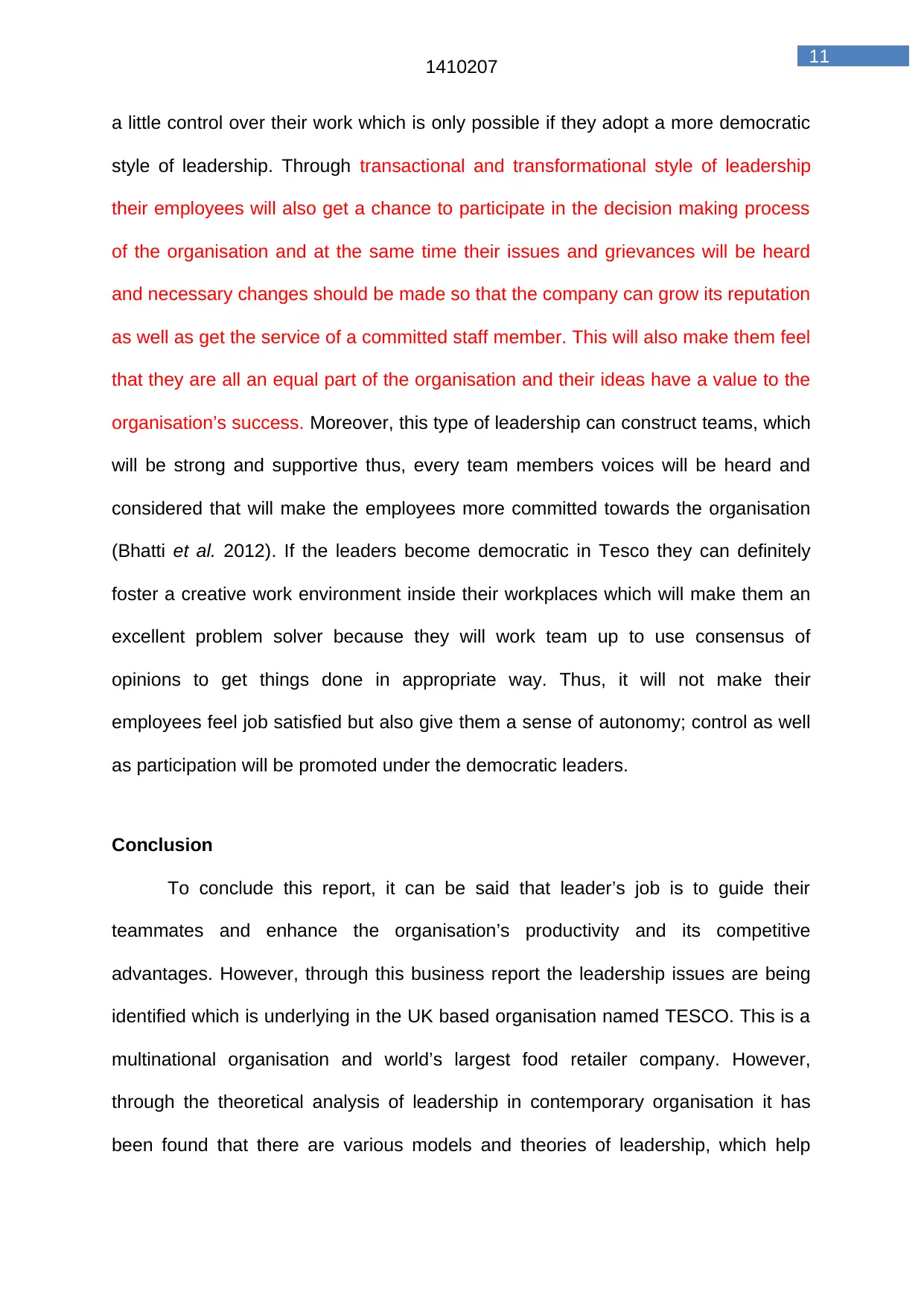
11
1410207
a little control over their work which is only possible if they adopt a more democratic
style of leadership. Through transactional and transformational style of leadership
their employees will also get a chance to participate in the decision making process
of the organisation and at the same time their issues and grievances will be heard
and necessary changes should be made so that the company can grow its reputation
as well as get the service of a committed staff member. This will also make them feel
that they are all an equal part of the organisation and their ideas have a value to the
organisation’s success. Moreover, this type of leadership can construct teams, which
will be strong and supportive thus, every team members voices will be heard and
considered that will make the employees more committed towards the organisation
(Bhatti et al. 2012). If the leaders become democratic in Tesco they can definitely
foster a creative work environment inside their workplaces which will make them an
excellent problem solver because they will work team up to use consensus of
opinions to get things done in appropriate way. Thus, it will not make their
employees feel job satisfied but also give them a sense of autonomy; control as well
as participation will be promoted under the democratic leaders.
Conclusion
To conclude this report, it can be said that leader’s job is to guide their
teammates and enhance the organisation’s productivity and its competitive
advantages. However, through this business report the leadership issues are being
identified which is underlying in the UK based organisation named TESCO. This is a
multinational organisation and world’s largest food retailer company. However,
through the theoretical analysis of leadership in contemporary organisation it has
been found that there are various models and theories of leadership, which help
1410207
a little control over their work which is only possible if they adopt a more democratic
style of leadership. Through transactional and transformational style of leadership
their employees will also get a chance to participate in the decision making process
of the organisation and at the same time their issues and grievances will be heard
and necessary changes should be made so that the company can grow its reputation
as well as get the service of a committed staff member. This will also make them feel
that they are all an equal part of the organisation and their ideas have a value to the
organisation’s success. Moreover, this type of leadership can construct teams, which
will be strong and supportive thus, every team members voices will be heard and
considered that will make the employees more committed towards the organisation
(Bhatti et al. 2012). If the leaders become democratic in Tesco they can definitely
foster a creative work environment inside their workplaces which will make them an
excellent problem solver because they will work team up to use consensus of
opinions to get things done in appropriate way. Thus, it will not make their
employees feel job satisfied but also give them a sense of autonomy; control as well
as participation will be promoted under the democratic leaders.
Conclusion
To conclude this report, it can be said that leader’s job is to guide their
teammates and enhance the organisation’s productivity and its competitive
advantages. However, through this business report the leadership issues are being
identified which is underlying in the UK based organisation named TESCO. This is a
multinational organisation and world’s largest food retailer company. However,
through the theoretical analysis of leadership in contemporary organisation it has
been found that there are various models and theories of leadership, which help
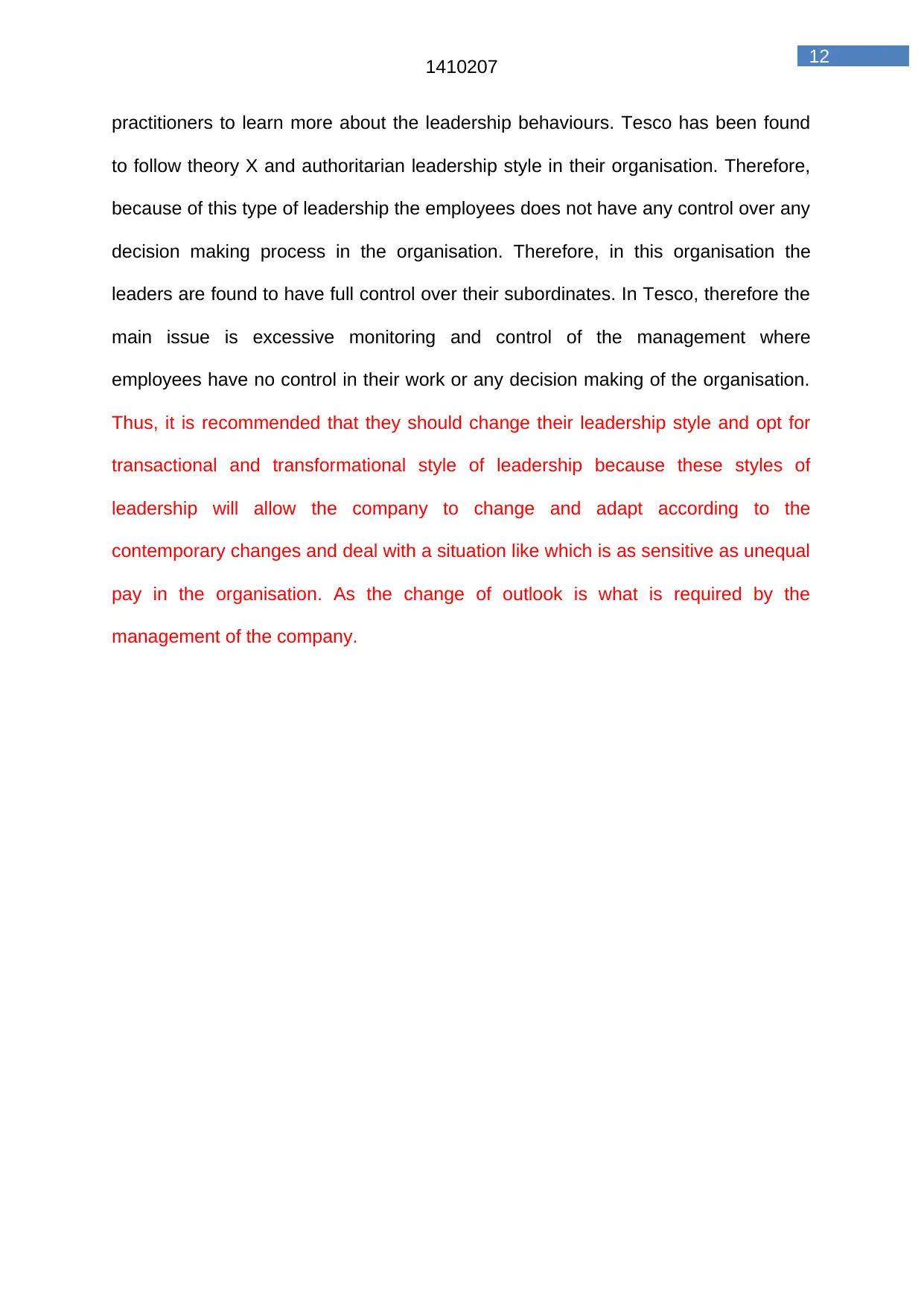
12
1410207
practitioners to learn more about the leadership behaviours. Tesco has been found
to follow theory X and authoritarian leadership style in their organisation. Therefore,
because of this type of leadership the employees does not have any control over any
decision making process in the organisation. Therefore, in this organisation the
leaders are found to have full control over their subordinates. In Tesco, therefore the
main issue is excessive monitoring and control of the management where
employees have no control in their work or any decision making of the organisation.
Thus, it is recommended that they should change their leadership style and opt for
transactional and transformational style of leadership because these styles of
leadership will allow the company to change and adapt according to the
contemporary changes and deal with a situation like which is as sensitive as unequal
pay in the organisation. As the change of outlook is what is required by the
management of the company.
1410207
practitioners to learn more about the leadership behaviours. Tesco has been found
to follow theory X and authoritarian leadership style in their organisation. Therefore,
because of this type of leadership the employees does not have any control over any
decision making process in the organisation. Therefore, in this organisation the
leaders are found to have full control over their subordinates. In Tesco, therefore the
main issue is excessive monitoring and control of the management where
employees have no control in their work or any decision making of the organisation.
Thus, it is recommended that they should change their leadership style and opt for
transactional and transformational style of leadership because these styles of
leadership will allow the company to change and adapt according to the
contemporary changes and deal with a situation like which is as sensitive as unequal
pay in the organisation. As the change of outlook is what is required by the
management of the company.
Paraphrase This Document
Need a fresh take? Get an instant paraphrase of this document with our AI Paraphraser
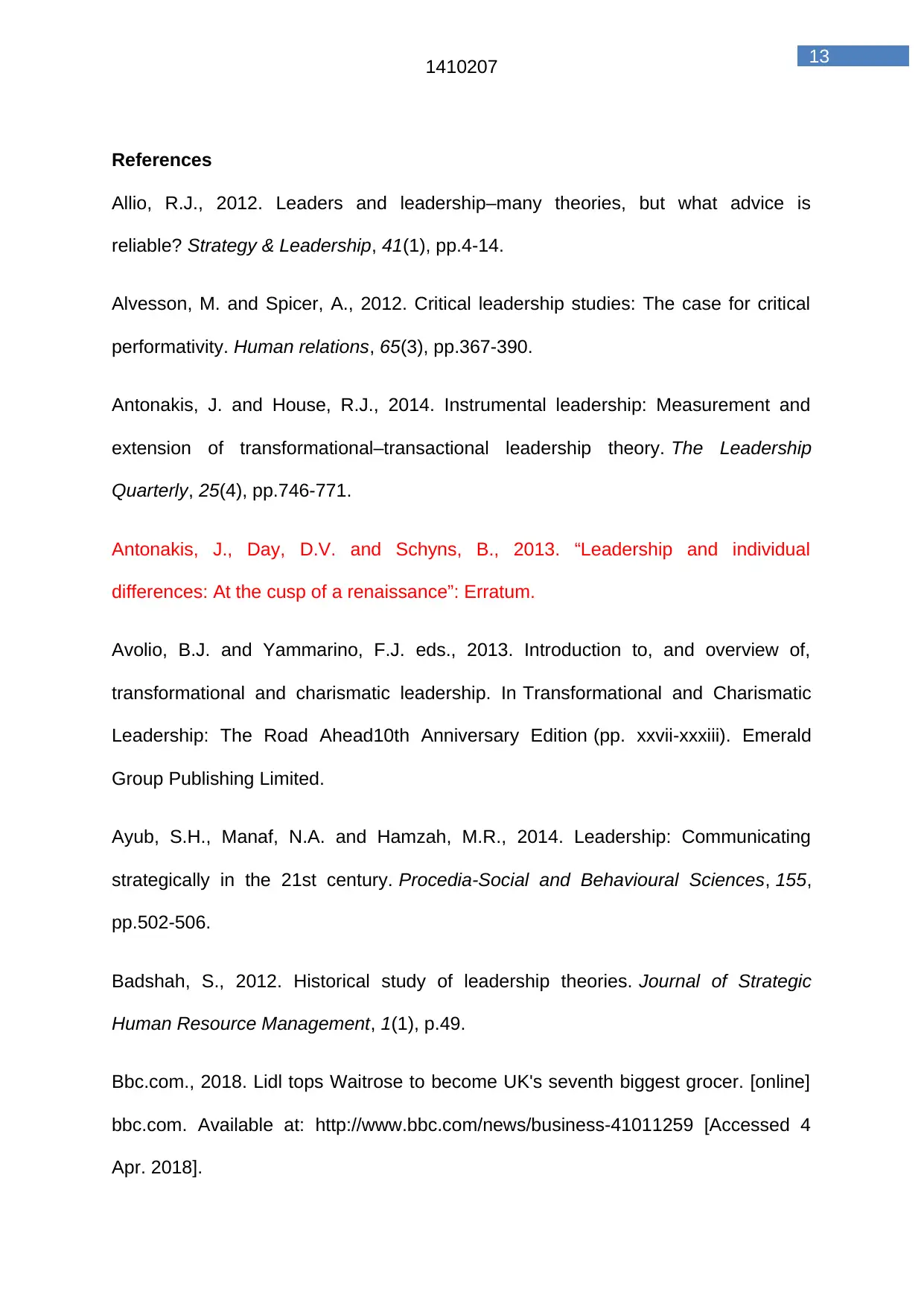
13
1410207
References
Allio, R.J., 2012. Leaders and leadership–many theories, but what advice is
reliable? Strategy & Leadership, 41(1), pp.4-14.
Alvesson, M. and Spicer, A., 2012. Critical leadership studies: The case for critical
performativity. Human relations, 65(3), pp.367-390.
Antonakis, J. and House, R.J., 2014. Instrumental leadership: Measurement and
extension of transformational–transactional leadership theory. The Leadership
Quarterly, 25(4), pp.746-771.
Antonakis, J., Day, D.V. and Schyns, B., 2013. “Leadership and individual
differences: At the cusp of a renaissance”: Erratum.
Avolio, B.J. and Yammarino, F.J. eds., 2013. Introduction to, and overview of,
transformational and charismatic leadership. In Transformational and Charismatic
Leadership: The Road Ahead10th Anniversary Edition (pp. xxvii-xxxiii). Emerald
Group Publishing Limited.
Ayub, S.H., Manaf, N.A. and Hamzah, M.R., 2014. Leadership: Communicating
strategically in the 21st century. Procedia-Social and Behavioural Sciences, 155,
pp.502-506.
Badshah, S., 2012. Historical study of leadership theories. Journal of Strategic
Human Resource Management, 1(1), p.49.
Bbc.com., 2018. Lidl tops Waitrose to become UK's seventh biggest grocer. [online]
bbc.com. Available at: http://www.bbc.com/news/business-41011259 [Accessed 4
Apr. 2018].
1410207
References
Allio, R.J., 2012. Leaders and leadership–many theories, but what advice is
reliable? Strategy & Leadership, 41(1), pp.4-14.
Alvesson, M. and Spicer, A., 2012. Critical leadership studies: The case for critical
performativity. Human relations, 65(3), pp.367-390.
Antonakis, J. and House, R.J., 2014. Instrumental leadership: Measurement and
extension of transformational–transactional leadership theory. The Leadership
Quarterly, 25(4), pp.746-771.
Antonakis, J., Day, D.V. and Schyns, B., 2013. “Leadership and individual
differences: At the cusp of a renaissance”: Erratum.
Avolio, B.J. and Yammarino, F.J. eds., 2013. Introduction to, and overview of,
transformational and charismatic leadership. In Transformational and Charismatic
Leadership: The Road Ahead10th Anniversary Edition (pp. xxvii-xxxiii). Emerald
Group Publishing Limited.
Ayub, S.H., Manaf, N.A. and Hamzah, M.R., 2014. Leadership: Communicating
strategically in the 21st century. Procedia-Social and Behavioural Sciences, 155,
pp.502-506.
Badshah, S., 2012. Historical study of leadership theories. Journal of Strategic
Human Resource Management, 1(1), p.49.
Bbc.com., 2018. Lidl tops Waitrose to become UK's seventh biggest grocer. [online]
bbc.com. Available at: http://www.bbc.com/news/business-41011259 [Accessed 4
Apr. 2018].
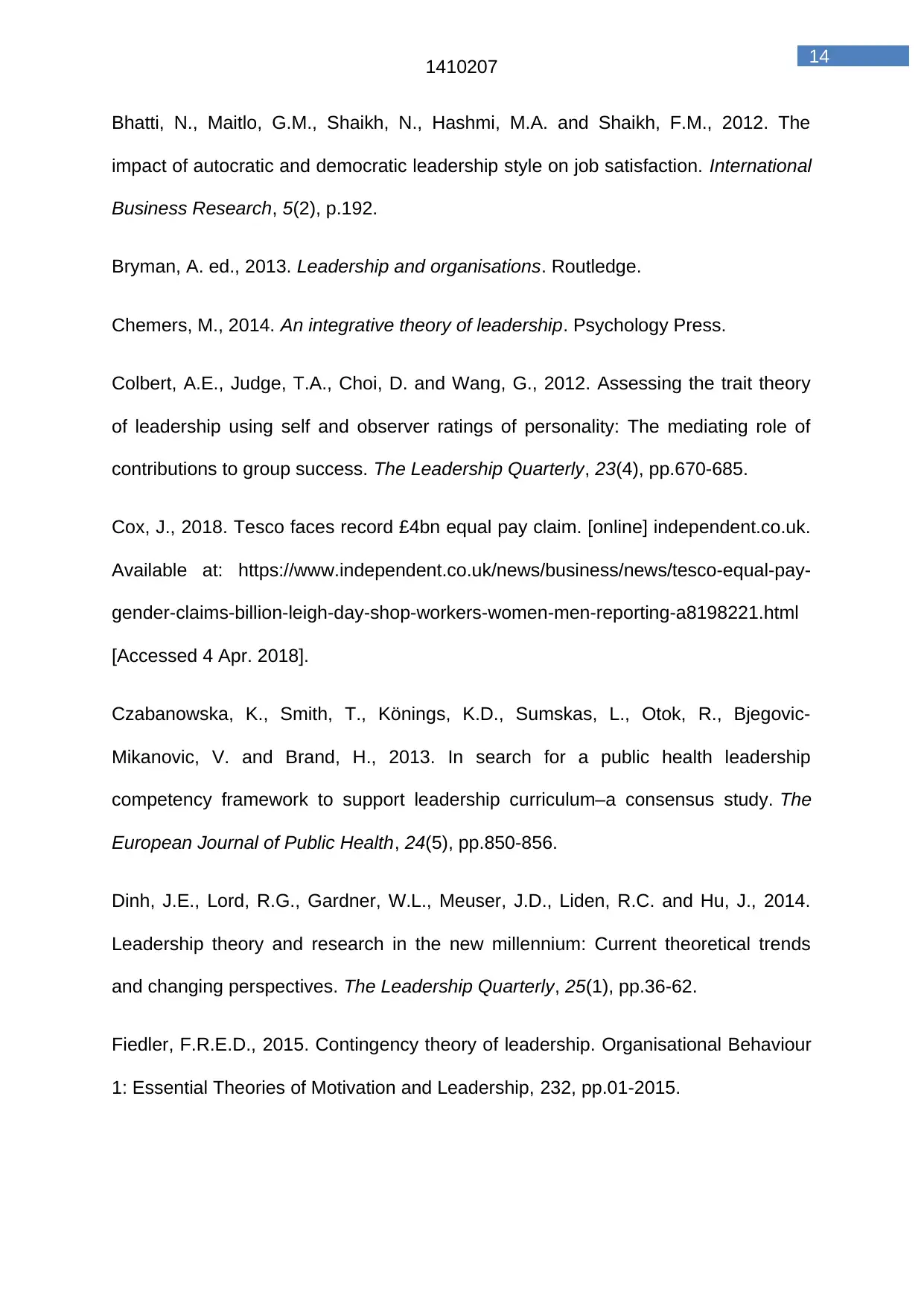
14
1410207
Bhatti, N., Maitlo, G.M., Shaikh, N., Hashmi, M.A. and Shaikh, F.M., 2012. The
impact of autocratic and democratic leadership style on job satisfaction. International
Business Research, 5(2), p.192.
Bryman, A. ed., 2013. Leadership and organisations. Routledge.
Chemers, M., 2014. An integrative theory of leadership. Psychology Press.
Colbert, A.E., Judge, T.A., Choi, D. and Wang, G., 2012. Assessing the trait theory
of leadership using self and observer ratings of personality: The mediating role of
contributions to group success. The Leadership Quarterly, 23(4), pp.670-685.
Cox, J., 2018. Tesco faces record £4bn equal pay claim. [online] independent.co.uk.
Available at: https://www.independent.co.uk/news/business/news/tesco-equal-pay-
gender-claims-billion-leigh-day-shop-workers-women-men-reporting-a8198221.html
[Accessed 4 Apr. 2018].
Czabanowska, K., Smith, T., Könings, K.D., Sumskas, L., Otok, R., Bjegovic-
Mikanovic, V. and Brand, H., 2013. In search for a public health leadership
competency framework to support leadership curriculum–a consensus study. The
European Journal of Public Health, 24(5), pp.850-856.
Dinh, J.E., Lord, R.G., Gardner, W.L., Meuser, J.D., Liden, R.C. and Hu, J., 2014.
Leadership theory and research in the new millennium: Current theoretical trends
and changing perspectives. The Leadership Quarterly, 25(1), pp.36-62.
Fiedler, F.R.E.D., 2015. Contingency theory of leadership. Organisational Behaviour
1: Essential Theories of Motivation and Leadership, 232, pp.01-2015.
1410207
Bhatti, N., Maitlo, G.M., Shaikh, N., Hashmi, M.A. and Shaikh, F.M., 2012. The
impact of autocratic and democratic leadership style on job satisfaction. International
Business Research, 5(2), p.192.
Bryman, A. ed., 2013. Leadership and organisations. Routledge.
Chemers, M., 2014. An integrative theory of leadership. Psychology Press.
Colbert, A.E., Judge, T.A., Choi, D. and Wang, G., 2012. Assessing the trait theory
of leadership using self and observer ratings of personality: The mediating role of
contributions to group success. The Leadership Quarterly, 23(4), pp.670-685.
Cox, J., 2018. Tesco faces record £4bn equal pay claim. [online] independent.co.uk.
Available at: https://www.independent.co.uk/news/business/news/tesco-equal-pay-
gender-claims-billion-leigh-day-shop-workers-women-men-reporting-a8198221.html
[Accessed 4 Apr. 2018].
Czabanowska, K., Smith, T., Könings, K.D., Sumskas, L., Otok, R., Bjegovic-
Mikanovic, V. and Brand, H., 2013. In search for a public health leadership
competency framework to support leadership curriculum–a consensus study. The
European Journal of Public Health, 24(5), pp.850-856.
Dinh, J.E., Lord, R.G., Gardner, W.L., Meuser, J.D., Liden, R.C. and Hu, J., 2014.
Leadership theory and research in the new millennium: Current theoretical trends
and changing perspectives. The Leadership Quarterly, 25(1), pp.36-62.
Fiedler, F.R.E.D., 2015. Contingency theory of leadership. Organisational Behaviour
1: Essential Theories of Motivation and Leadership, 232, pp.01-2015.
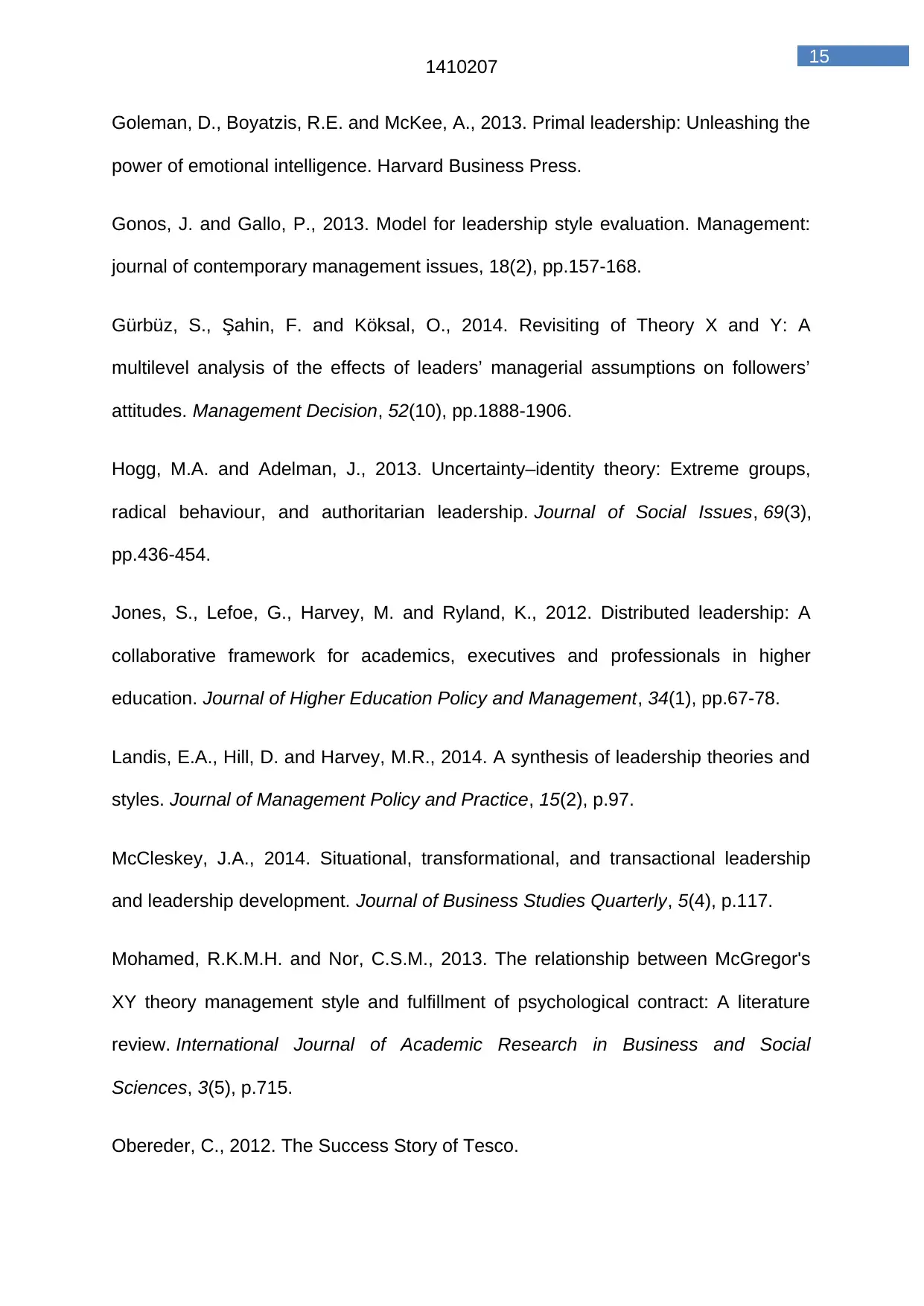
15
1410207
Goleman, D., Boyatzis, R.E. and McKee, A., 2013. Primal leadership: Unleashing the
power of emotional intelligence. Harvard Business Press.
Gonos, J. and Gallo, P., 2013. Model for leadership style evaluation. Management:
journal of contemporary management issues, 18(2), pp.157-168.
Gürbüz, S., Şahin, F. and Köksal, O., 2014. Revisiting of Theory X and Y: A
multilevel analysis of the effects of leaders’ managerial assumptions on followers’
attitudes. Management Decision, 52(10), pp.1888-1906.
Hogg, M.A. and Adelman, J., 2013. Uncertainty–identity theory: Extreme groups,
radical behaviour, and authoritarian leadership. Journal of Social Issues, 69(3),
pp.436-454.
Jones, S., Lefoe, G., Harvey, M. and Ryland, K., 2012. Distributed leadership: A
collaborative framework for academics, executives and professionals in higher
education. Journal of Higher Education Policy and Management, 34(1), pp.67-78.
Landis, E.A., Hill, D. and Harvey, M.R., 2014. A synthesis of leadership theories and
styles. Journal of Management Policy and Practice, 15(2), p.97.
McCleskey, J.A., 2014. Situational, transformational, and transactional leadership
and leadership development. Journal of Business Studies Quarterly, 5(4), p.117.
Mohamed, R.K.M.H. and Nor, C.S.M., 2013. The relationship between McGregor's
XY theory management style and fulfillment of psychological contract: A literature
review. International Journal of Academic Research in Business and Social
Sciences, 3(5), p.715.
Obereder, C., 2012. The Success Story of Tesco.
1410207
Goleman, D., Boyatzis, R.E. and McKee, A., 2013. Primal leadership: Unleashing the
power of emotional intelligence. Harvard Business Press.
Gonos, J. and Gallo, P., 2013. Model for leadership style evaluation. Management:
journal of contemporary management issues, 18(2), pp.157-168.
Gürbüz, S., Şahin, F. and Köksal, O., 2014. Revisiting of Theory X and Y: A
multilevel analysis of the effects of leaders’ managerial assumptions on followers’
attitudes. Management Decision, 52(10), pp.1888-1906.
Hogg, M.A. and Adelman, J., 2013. Uncertainty–identity theory: Extreme groups,
radical behaviour, and authoritarian leadership. Journal of Social Issues, 69(3),
pp.436-454.
Jones, S., Lefoe, G., Harvey, M. and Ryland, K., 2012. Distributed leadership: A
collaborative framework for academics, executives and professionals in higher
education. Journal of Higher Education Policy and Management, 34(1), pp.67-78.
Landis, E.A., Hill, D. and Harvey, M.R., 2014. A synthesis of leadership theories and
styles. Journal of Management Policy and Practice, 15(2), p.97.
McCleskey, J.A., 2014. Situational, transformational, and transactional leadership
and leadership development. Journal of Business Studies Quarterly, 5(4), p.117.
Mohamed, R.K.M.H. and Nor, C.S.M., 2013. The relationship between McGregor's
XY theory management style and fulfillment of psychological contract: A literature
review. International Journal of Academic Research in Business and Social
Sciences, 3(5), p.715.
Obereder, C., 2012. The Success Story of Tesco.
Secure Best Marks with AI Grader
Need help grading? Try our AI Grader for instant feedback on your assignments.
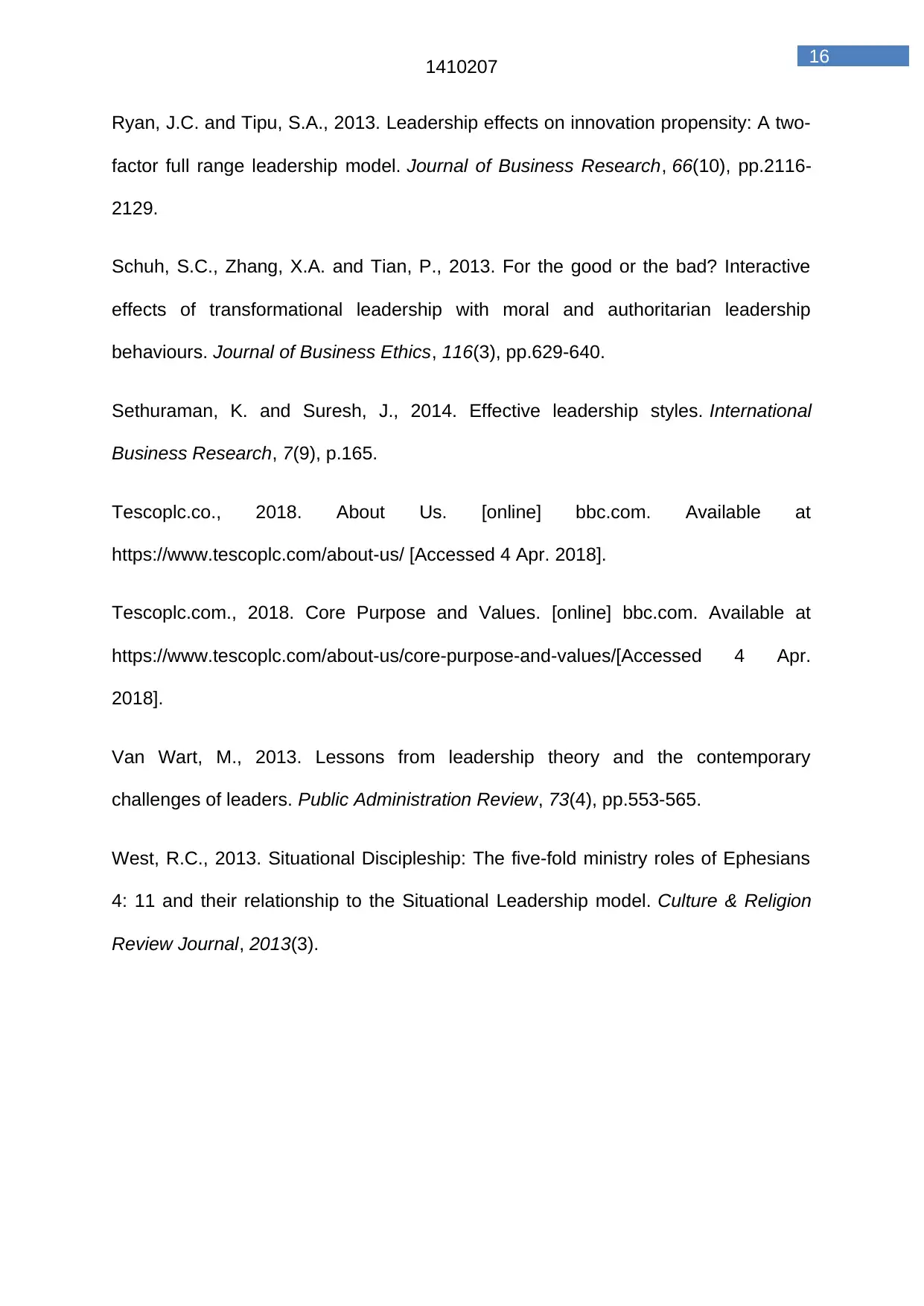
16
1410207
Ryan, J.C. and Tipu, S.A., 2013. Leadership effects on innovation propensity: A two-
factor full range leadership model. Journal of Business Research, 66(10), pp.2116-
2129.
Schuh, S.C., Zhang, X.A. and Tian, P., 2013. For the good or the bad? Interactive
effects of transformational leadership with moral and authoritarian leadership
behaviours. Journal of Business Ethics, 116(3), pp.629-640.
Sethuraman, K. and Suresh, J., 2014. Effective leadership styles. International
Business Research, 7(9), p.165.
Tescoplc.co., 2018. About Us. [online] bbc.com. Available at
https://www.tescoplc.com/about-us/ [Accessed 4 Apr. 2018].
Tescoplc.com., 2018. Core Purpose and Values. [online] bbc.com. Available at
https://www.tescoplc.com/about-us/core-purpose-and-values/[Accessed 4 Apr.
2018].
Van Wart, M., 2013. Lessons from leadership theory and the contemporary
challenges of leaders. Public Administration Review, 73(4), pp.553-565.
West, R.C., 2013. Situational Discipleship: The five-fold ministry roles of Ephesians
4: 11 and their relationship to the Situational Leadership model. Culture & Religion
Review Journal, 2013(3).
1410207
Ryan, J.C. and Tipu, S.A., 2013. Leadership effects on innovation propensity: A two-
factor full range leadership model. Journal of Business Research, 66(10), pp.2116-
2129.
Schuh, S.C., Zhang, X.A. and Tian, P., 2013. For the good or the bad? Interactive
effects of transformational leadership with moral and authoritarian leadership
behaviours. Journal of Business Ethics, 116(3), pp.629-640.
Sethuraman, K. and Suresh, J., 2014. Effective leadership styles. International
Business Research, 7(9), p.165.
Tescoplc.co., 2018. About Us. [online] bbc.com. Available at
https://www.tescoplc.com/about-us/ [Accessed 4 Apr. 2018].
Tescoplc.com., 2018. Core Purpose and Values. [online] bbc.com. Available at
https://www.tescoplc.com/about-us/core-purpose-and-values/[Accessed 4 Apr.
2018].
Van Wart, M., 2013. Lessons from leadership theory and the contemporary
challenges of leaders. Public Administration Review, 73(4), pp.553-565.
West, R.C., 2013. Situational Discipleship: The five-fold ministry roles of Ephesians
4: 11 and their relationship to the Situational Leadership model. Culture & Religion
Review Journal, 2013(3).
1 out of 17
Related Documents
Your All-in-One AI-Powered Toolkit for Academic Success.
+13062052269
info@desklib.com
Available 24*7 on WhatsApp / Email
![[object Object]](/_next/static/media/star-bottom.7253800d.svg)
Unlock your academic potential
© 2024 | Zucol Services PVT LTD | All rights reserved.





